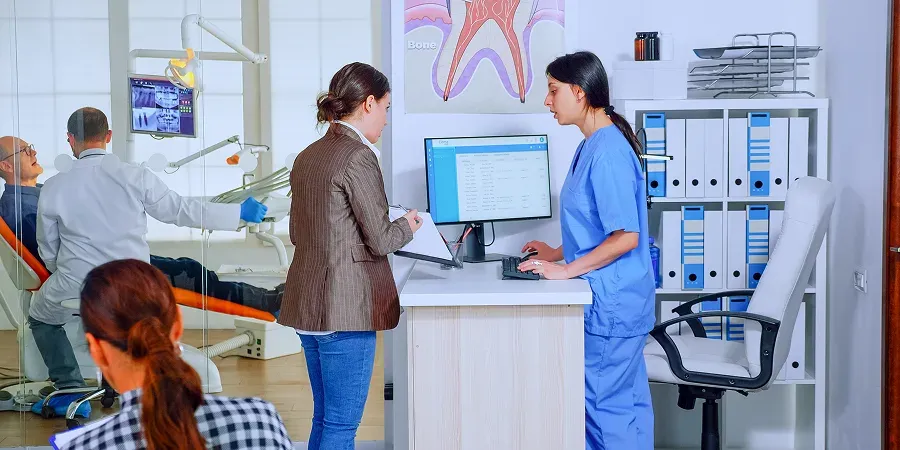Aligning Dental Marketing with Operational Gaps in Dentistry
by Emily Brown
11 July 2025

This case serves as a reminder that dental workflow improvements and marketing optimization should grow in parallel.
In today's digital-first healthcare environment, dental clinics are investing heavily in online visibility. However, aligning dental marketing with the actual capacity and workflows of a practice is where most clinics fall short. This case study focuses on how one dental clinic closed the gap between patient acquisition and service delivery, using a strategy built on marketing and operations alignment.
"Great marketing gets patients through the door, but only great systems can keep them coming back."

Background: A Disconnected Yet Growing Practice
This case study: fixing operational gaps in dental clinics centers on BrightSmile Dental, a mid-sized practice with a highly active digital presence. The clinic recently invested in paid ads, SEO campaigns, and social media content to grow its brand and patient base. Despite seeing an increase in bookings and website traffic, the team began to face operational strain.
Patients experienced:
- Appointment delays
- Unanswered queries
- Overpromised service timelines
The bottleneck wasn’t in lead generation — it was in dental workflow improvements. The marketing engine was running full speed, while the backend system lacked the efficiency to support the growth.
Identifying the Problem: Operational Gaps in Dentistry
Using performance tracking analytics, the clinic uncovered key issues:
- Missed follow-ups were causing patient attrition
- Manual data entry led to errors in scheduling
- Misalignment between promotional offers and real-time availability
- Lack of structured handoffs between the marketing and treatment teams
The disconnect highlighted the urgent need for dental operational efficiency through better collaboration and technology adoption.
This scenario underscores the question many practices are asking: how to align marketing and operations in dentistry without disrupting ongoing services?
Strategy and Planning: Aligning Dental Teams and Campaigns
The first step was to conduct a joint review involving both the marketing and operations teams. The insights were eye-opening:
- The marketing team was unaware of chair time availability before launching promos
- Front desk staff weren’t trained to handle the surge in inquiries during campaigns
- Patients were often confused due to mismatched communication on different platforms
To resolve these, the clinic adopted a holistic approach based on practice management solutions designed for synchronizing marketing campaigns with operational readiness.
Goals Defined:
- Align messaging with actual service delivery timelines
- Improve appointment flow and reduce backlogs
- Establish real-time data sharing between departments
This formed the backbone of a robust marketing optimization case study that could later serve as a model for similar practices.
Execution: Improving Marketing Impact Through Better Workflows
1. Implementation of Practice Management Software
The clinic introduced a cloud-based tool that integrated patient scheduling, marketing campaigns, and internal communication. This played a major role in dental process optimization, especially by automating:
- Real-time updates to Google My Business and social ads
- Availability tracking synced with chair-side software
- Automated follow-ups and reminders for no-shows
2. Performance Tracking Analytics Dashboards
Using visual dashboards, both marketing and operational teams could now access shared KPIs:
- Response time to inquiries
- Campaign-based booking conversions
- Average wait time per patient during campaign peaks
This setup empowered improving team coordination as everyone worked from the same data stream.
3. Weekly Alignment Meetings
The marketing team started weekly sync calls with treatment coordinators to plan content and offers around actual availability. This ongoing collaboration enabled aligning dental teams and campaigns around what the clinic could realistically deliver.
"When the front desk knows what’s being promoted and why, they serve patients better. That alone improves conversions." — Clinical Coordinator
Marketing Meets Operations: Success Stories of Operational Improvements
Once the systems were in place, the clinic began seeing noticeable changes. With marketing efforts aligned with operations, the staff felt less overburdened, and patient reviews improved significantly.
Before Optimization:
- Over 30% of leads dropped off after first inquiry
- Average wait time for new patients: 9 days
- Staff stress reported weekly in internal surveys
After Dental Workflow Improvements:
- Lead conversion improved by 42%
- Wait time dropped to 4.5 days
- Patients cited “better experience” in over 60% of feedback
These results demonstrate that aligning dental marketing with the practice’s true delivery potential is not just a tech issue — it’s a strategic necessity.
Midway Takeaway: Practice-Wide Synergy Drives Growth
This journey is a testament to the power of unified teams. When the clinic realigned its promotional messaging and backend workflows, it created a win-win:
- Patients experienced smoother care journeys
- Staff had less stress and better time management
- Marketing gained stronger ROI without increasing ad spend
This reinforces the industry trend: improving marketing impact through better workflows isn't just a theory — it's the future of dentistry.
Results: The Strategic Impact of Marketing and Operations Alignment
The shift in mindset from isolated functions to a synchronized approach created measurable improvements across departments. This wasn’t just a one-off success — it became a blueprint for sustainable growth.
1. Enhanced Dental Operational Efficiency
By integrating real-time scheduling, response automation, and cross-department communication, the clinic reported a:
- 48% reduction in missed appointments
- 35% increase in successful treatment plan acceptances
- Improved reputation scores on review platforms
The changes also streamlined the clinic’s administrative workload. Manual errors that previously slowed down workflows were significantly reduced through dental process optimization.
2. Smarter Campaign Execution
With aligned timelines and shared dashboards, promotional campaigns were now based on:
- Available appointment windows
- Staff bandwidth
- Service capacity
The result? Fewer refunds or rescheduling issues, leading to a more predictable return on investment for ad spend.
This realignment further strengthened the case for continuous marketing optimization, as performance tracking analytics clearly demonstrated the link between internal readiness and external campaign performance.
The Takeaway: Aligning Dental Marketing is a Strategic Necessity
The success of this marketing optimization case study proves that aligning dental marketing with internal systems isn’t optional — it’s mission-critical. In a digital-first world, patient expectations are shaped by the promises made online. Failing to fulfill those expectations results in lost trust, negative reviews, and wasted resources.
“Patients today don’t just look for dental care — they look for consistency. From first click to post-treatment follow-up, every touchpoint matters.”
This is why the question of how to align marketing and operations in dentistry needs to be a boardroom discussion, not just a marketing meeting topic.

Key Learnings: Aligning Dental Teams and Campaigns
- Transparency improves performance
Shared tools and synced dashboards foster improving team coordination and remove ambiguity between roles. - Campaigns should follow operations, not lead them
Launching a marketing campaign before confirming internal readiness can backfire. Real-time tracking and forecasting help avoid mismatches. - Small process tweaks lead to big wins
Sometimes, operational gaps in dentistry aren’t about massive overhauls but minor delays, unclear workflows, or missing SOPs. - Invest in the right technology
Smart practice management solutions help bridge the marketing-to-treatment pipeline with automation, alerts, and performance reports.
Conclusion
In this increasingly competitive and digital dental landscape, marketing and operations alignment isn’t a one-time effort — it’s a continuous commitment. Clinics that treat this alignment as part of their strategy, not just support, will see long-term gains in revenue, loyalty, and efficiency.
This case serves as a reminder that dental workflow improvements and marketing optimization should grow in parallel. When both functions speak the same language and operate from shared goals, practices thrive — not just in bookings, but in long-term trust and outcomes.
If you're a dental clinic struggling with missed opportunities despite great marketing, it's time to shift focus inward. Aligning dental marketing with real-world service capability isn't just good for operations — it's great for your brand.
Emily Brown
Author Title